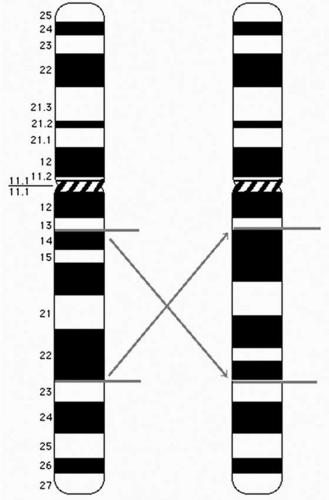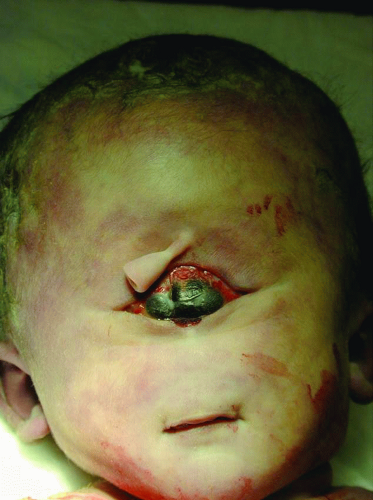Molecular Pathology and Genetics
Ronald M. Przygodzki
▪ Questions and Answers
1. The missense mutation Ser810Lys in the mineralocorticoid receptor results in:
a. Neoplastic processes unresponsive to hormonal therapy
b. Dominant form of pseudohypoaldosteronism
c. Early-onset hypertension that is exacerbated by pregnancy
d. Early-onset hypertension that is not accelerated by pregnancy
e. A constitutively activated receptor with abnormal activation by aldosterone
View Answer
1. c. Patients with the Ser810Lys mutation have severe hypertension, which present mostly before age 20. The mutation is not associated with neoplastic formation. The dominant forms of pseudohypoaldosteronism are secondary to the following inactivating mutations: ΔG1226, ΔT1597, C/T1831stop, and ΔA intron splice site. The mutation results in a constitutively activated mineralocorticoid receptor; however, it retains its normal activation by aldosterone.
2. Which of the following NAT1 gene variants retains normal enzyme activity?
a. NAT1*1
b. NAT1*2
c. NAT1*8
d. NAT1*14
e. NAT1*15
View Answer
2. a. All polymorphisms with a “star” *1 are considered to be wild-type by convention. Hence, all other variants are altered, leading to either excess, depressed, or absent production.
3. An increased level of S-warfarin, under standard anticoagulant drug dosage, would be expected in a patient with which of the following polymorphisms?
a. CYP2C9*2
b. CYP2C9*3
c. CYP2C19*2
d. All of the above
e. Only a and b are correct.
View Answer
3. e. Individuals with CYP2C9*2 and CYP2C9*3 have an impaired metabolism of S-warfarin, which leads to an increased plasma concentration of the drug despite standard dosing. Hence, such patients will experience an increased risk for serious or life-threatening bleeding complications despite obtaining a standard dose of medication. The VKORC1 polymorphism likewise has a role in warfarin therapy.
4. Which of the following does NOT support the Hardy-Weinberg law of population genetics?
a. It enables one to have the ability to take information about the frequency of alleles in the population and make predictions about the frequency of genotype in the population.
b. Individuals with all genotypes are equally capable of mating and passing on their genes (there is no selection against any particular genotype).
c. Rate of mutation will not have an appreciable effect.
d. The population tested is large and matings are expected to be random with respect to the locus in question.
e. There is no significant immigration of individuals from a population with allele frequencies markedly different from the endogenous population.
View Answer
4. c. Genetic equilibrium is a basic principle of population genetics. Violations of the Hardy-Weinberg law can cause deviations from expectation. Among such deviations are inbreeding/co-sanguinuity (increases homozygosity for all genes), small population size (can cause random change in genotypic frequency – also known as genetic drift), and assortative mating (causes an increase of homozygosity only of those genes involved in the trait). The law further assumes that there is no appreciable rate of mutation; changes in this manner would affect the allelic frequencies, which are assumed to be constant.
5. What type of structural chromosomal abnormality is identified in Figure 18.1?
a. Insertion
c. Derivative chromosome
d. Isochromosome
e. Paracentric inversion
View Answer
5. e. Paracentric inversion consists of an inversion within a given arm of the chromosome. Insertions “insert” additional chromosome, whereas duplication inserts a portion of duplicated chromosome. Isochromosomes lose one of the chromosome arms and contains a duplicate inverted other chromosome arm (e.g., 2p arms in mirror image at centromere).
6. A stillbirth is presented to you at autopsy. The family is worried that another birth might yield a child with similar phenotypic features. The mother is noted to lack a superior labial frenulum. Given the facial features of this child (Fig. 18.2) and the family history, which of the following molecular and genetic findings are correct?
a. The nonsyndromic form of this disease is exclusively autosomal recessive.
b. It occurs with an equal male:female distribution.
c. Most common gene alteration is a gain-of-function mutation.
d. You should have the family members evaluated for Sonic Hedgehog mutation.
e. Patients exclusively present with marked facial dysmorphism, cyclopia, and marked central nervous system malformations.
View Answer
6. d. The picture depicts a child with holoprosencephaly. Nonsyndromic forms of holoprosencephaly are predominantly autosomal dominant, with an incidence of 1 in 10,000 to 1 in 12,000 births. Autosomal recessive and X-linked recessive forms do occur, however are rare. It affects twice as many girls as it does boys. The facial dysmorphisms occur as a spectrum, with mild alterations including lack of frontal incisor, lack of superior labial frenulum, hypotelorism or hypertelorism, bifid uvula all the way to marked CNS alterations, including alobar holoprosencephaly. Sonic Hedgehog (SHH) mutations are loss-of-function mutations and account for nearly 40% of familial nonsyndromic autosomal dominant holoprosencephaly. Other genes implicated in this disease include ZIC2, PTCH, and TGIF.
7. Which of the following statements pertaining to Prader-Willi syndrome (PWS) is correct?
a. Hypogonadism is present in both males and females.
b. Maternal deletions of 15q11-q13 accounts for approximately 70% to 80% of alterations.
c. The estimated prevalence of PWS is 1/500,000.
d. Spontaneous mutations account for approximately 15% of alterations.
e. Paternal uniparental disomy of chromosome 15 accounts for approximately 25% of alterations.
View Answer
7. a. Loss of the paternal allele of the PWS/AS region on chromosome 15 accounts for the syndrome; maternal uniparental disomy (˜ 25%) and paternal deletion of 15q11-q13 (˜ 70% to 80%) account for the brunt of alterations. An additional however small component (< 5%) imprinting defects are noted; however, mutations, per se, do not occur in PWS. The prevalence of PWS is 1/10,000 to 1/15,000. Hypogonadism is present in both males and females, with most individuals unable to reproduce.
8. Which of the following antibody against tumor antigen/tumor antigen combinations is INCORRECT?
a. Bevacizumab (Avastin)/VEGF
b. Rituximab (Rituxan)/CD52 lymphocyte surface antigen
c. Cetuximab (Erbitux)/EGFR
d. Trastuzumab (Herceptin)/HER2 receptor
e. Panitumumab (ABX-EGF)/EGFR
View Answer
8. b. Rituximab is directed against CD20 B-cell surface antigen and is used for therapy in non-Hodgkin lymphoma. The CD52 lymphocyte surface antigen antibody used for treatment of CLL and T-cell lymphomas is alemtuzumab (Campath).
9. Which of the following is correct with respect to myotonic dystrophy type I?
a. It is the least common dystrophy presenting in adults.
b. Involves an expansion of the CCG triplet repeat.
c. It is a disease of chromosome 16.
d. May cause sudden death and myocardial fibrosis.
e. The triplet repeat expansion involves the 5′ untranslated region.
View Answer
9. d. Myotonic dystrophy type I is the most common muscular dystrophy presenting in adults. It is characterized by myotonia, progressive weakness, and atrophy of skeletal muscles, as well as systemic manifestations including cardiac involvement. The cardiac involvement initially manifests as asymptomatic ECG abnormalities, prolonged PR and QRS duration leading to arrhythmia, progressive heart block, and trial/ventricular fibrillation. Sudden death may occur as a consequence of myocardial fibrosis and degeneration of the cardiac-conduction system. The CTG triplet repeat expansion is found in the 3′ untranslated region of the DMPK (dystrophia myotonica protein kinase) gene.
10. Which of the following in NOT valid for Kerns-Sayre syndrome (KSS)?
a. It is a mitochondrial myopathy.
b. It is very rarely inherited maternally.
c. Mitochondrial homoplasmy is present.
d. Mitochondria with the alteration are more localized to muscle and CNS.
e. Onset of disease is in infancy/early childhood.
View Answer
10. c. KSS by rule is heteroplasmic. KSS is exceedingly rarely inherited maternally and if present, it is due to mtDNA duplication. Spontaneous mtDNA rearrangements/deletions are noted in ˜80% of cases. The most common deletion (˜ 30%) is 4.9kb in size.
11. Which of the following is NOT deemed a tumor suppressor gene?
a. RON
b. Rb
c. APC
d. VHL
e. P53
View Answer
11. a. RON (macrophage-stimulating 1 receptor, MST1R) is a member of the receptor tyrosine kinase gene family that includes the MET oncogene.
12. You decide to identify whether you have loss of heterozygosity by PCR using one fluorescently labeled and a second unlabeled oligonucleotide primer set in a particular tumor and nontumor sample. You further know that the primers span a region of AT repeats. The PCR of the tumor reveals a single band, similar to that found in the nontumor sample. The positive and negative control samples produced appropriate results. Which of the following statement is correct?
a. LOH is informative in the tumor sample.
b. The sample may or may not have LOH.
c. The sample does not have LOH and is informative.
d. Direct sequencing may be required to identify LOH.
e. You require the use of a new set of primers.
View Answer
12. b. LOH testing required that a sample have two DNA strands of varying length of the region being amplified in the non-tumor sample in order to be informative. In this way, PCR amplification reveals two bands, both of different sizes, in this case in Nx2 bp difference. LOH would be considered when two bands were to be present in the non-tumor sample and one band to be present in the tumor sample. Because the normal sample in this question reveals a single band, it might be assumed that both strands are of the same length therefore uninformative; however, the region being testing may be missing from one of the chromosome arms, therefore producing a single PCR product. Neither sequencing nor new primer sets for the region will resolve such questions; however, testing on the level where chromosome copy number is determined (e.g., comparative genomic hybridization, karyotyping, copy number variant testing) should resolve such cases more definitively.
13. Which of the following genes may be inactivated by hypermethylation?
a. BRCA1
b. MLH1
c. KRAS
d. Rb
e. P16
View Answer
13. c. KRAS, an oncogene, is typically activated by mutation – methylation does not play a role in activating oncogenes. Hypermethylation of MLH1 (colon, endometrial cancer), P16 (esophageal, lung cancer), RB, and BRAC1 (breast ovarian cancer) are tumor suppressor genes that may either be inactivated by mutation or hypermethylation. Either path to inactivation leads to detrimental outcomes in these genes.
14. Which of the following is correct with respect to herpes simple virus?
a. Two type are identified – HSV1 with genital and HSV2 with orofacial lesions.
b. No FDA-approved methods are available for HSV PCR-based molecular testing.
c. Direct detection by Tzanck stain is superior to all detection methods.
d. RT-PCR is not possible on CSF samples.
e. Acute necrotizing encephalitis associated with HSV is localized to the base of the brain.
View Answer
14. b. Indeed, no molecular based HSV




Stay updated, free articles. Join our Telegram channel

Full access? Get Clinical Tree




